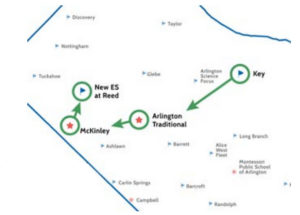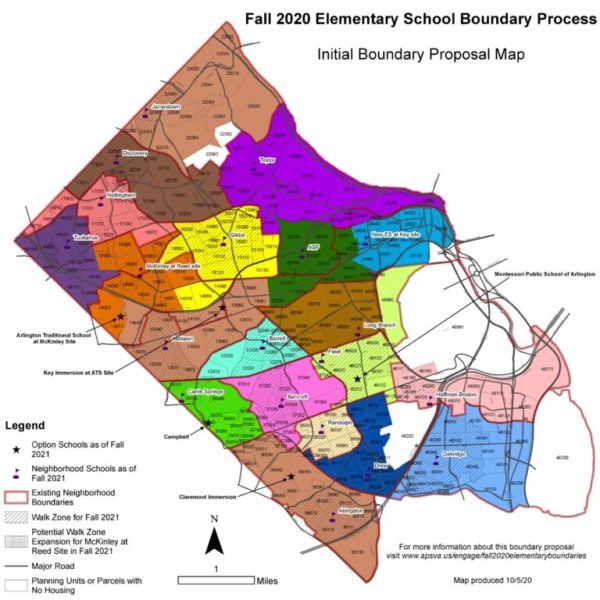(Updated at 11:50 a.m.) About 1,400 elementary students would be reassigned to new school buildings next fall, according to a proposed change in boundaries that Arlington Public Schools released Monday evening.
The boundary proposal follows an elementary school building swap approved by the School Board in February, to account for the new Reed School building in Westover coming online and the former home of the Key Spanish immersion program near Courthouse being converted to a neighborhood school.
 The proposal includes new neighborhood boundaries around Arlington Science Focus School.
The proposal includes new neighborhood boundaries around Arlington Science Focus School.
The boundary changes are part of the school system’s effort to prepare for an estimated 30,000 students in 2021, including a surge in new students near the Courthouse neighborhood.
APS is looking to redraw the boundaries of most, if not all, of its 24 elementary schools in the near future to address a growing imbalance between where enrollment is increasing and where there is spare school capacity, while taking equity and walkability into consideration.
APS redrew boundaries for some elementary schools in 2018, and before that in 2015 and 2013 — all were, to some degree, contentious processes.
The School Board is scheduled to vote on the latest boundary proposal on Dec. 3.
The 1,400 students — 13% of K-5 neighborhood school students — would be reassigned from Ashlawn, ASFS, Glebe, Long Branch, McKinley, Taylor and Tuckahoe schools, APS said.
“Our long-term priority is to address capacity needs informed by a plan that puts equity and instruction front and center, and that ensures we consider the overall needs of our students and school division rather than focus on an individual school, department or topic,” Superintendent Francisco Durán said in a statement.
He added that the district must make this change “as we move from being a system of schools to a school system.”
APS had planned to address boundaries for most elementary schools in 2020, but the pandemic disrupted education and strained families to the point that Durán decided to keep students together as much as possible.
The new boundary change approach keeps more students at their current schools and adds 800 students to school walk zones, reducing the need for busing at a time when only 11 students can ride each bus at a time. One downside: there will be an increased need for portable classroom trailers.
APS says it will continue to plan for increased school capacity where enrollment is spiking, particularly at the western end of Columbia Pike, with the upcoming Fiscal Year 2022 Capital Improvement Plan.
Virtual community meetings on the boundary proposal will be held from 7-8:30 p.m. tomorrow (Wednesday) and next Wednesday, Oct. 14. Community members can provide input this fall through a community questionnaire, available through Oct. 20.
APS staff will present the superintendent’s final proposal to the School Board on Nov. 5, and will hold a public hearing on Dec. 1, before adoption on Dec. 3.
More from an APS press release, below.
Today, Arlington Public Schools (APS) published a proposal for new elementary school boundaries for 2021-22. The proposal creates attendance zones for the new neighborhood school at the Key site and for McKinley in the new facility at the Reed site, both of which will open in Fall 2021, as well as neighborhood boundaries around Arlington Science Focus School (ASFS). Approximately 1,400 students — 13% of Grade K-5 neighborhood school students — would be reassigned from seven schools: Ashlawn, ASFS, Glebe, Long Branch, McKinley, Taylor and Tuckahoe. The School Board is scheduled to adopt new boundaries on December 3, 2020.
Nearly half of the 1,400 students reassigned in this proposal are current ASFS students who would attend the new neighborhood elementary school at the Key site, which is in closer proximity to where they live than their current building. In addition to these 1,400 students, about 500 McKinley students will move with their school administration and staff to the new building at the Reed site, putting nearly 60% of its students in the school’s walk zone as compared to 28% at the current McKinley site.
APS had planned to address boundaries for most, if not all, elementary schools in 2020; however, given the disruption of the pandemic and the strain on families, APS Superintendent Dr. Francisco Durán narrowed the scope of the process to minimize the number of students reassigned to another school and keep more students together as much as possible. This modified approach includes the use of relocatable classrooms to manage enrollment and places more students within walking distance or a shorter bus ride to their assigned neighborhood school. The proposal would result in a net gain of about 800 more students who can walk to school, with 19 out of 20 neighborhood elementary schools containing their entire walk zones within their boundaries.
“We recognize the stress that families are experiencing at this time and we are looking to make limited elementary school boundary changes this year. We want these adjustments to allow flexibility so we can continue to address enrollment growth through capital planning and future boundary processes,” said Superintendent Dr. Durán. “Our long-term priority is to address capacity needs informed by a plan that puts equity and instruction front and center, and that ensures we consider the overall needs of our students and school division rather than focus on an individual school, department or topic. This is a change we must make as we move from being a system of schools to a school system.”
At some schools, APS will manage enrollment for one or two years with relocatable classrooms, program moves and other options. APS will continue to monitor enrollment and undertake an additional elementary school boundary process in other areas when more normal operations resume, and within the next two years. Future processes will be guided by the PreK-12 Instructional Program Pathways (IPP) framework that establishes multiple pathways for student success within the blend of APS neighborhood schools and options/programs.
The boundary process this fall is part of a long-term APS planning initiative to ensure sufficient elementary school capacity and follows a School Board decision in February to address a large imbalance across the county between where students live and where APS has capacity. APS will continue planning to provide elementary school capacity where it is needed, particularly at the western end of Columbia Pike, with the upcoming Fiscal Year 2022 Capital Improvement Plan (CIP).
Community engagement for this boundary process began in May with an early review of data and methodology with stakeholders; staff worked over the summer to use this input in refining the data to be used in developing new boundaries. Data used in this process comes from elementary school student enrollment on September 30, 2019. In follow-up to gathering community input, staff worked with Arlington County to review and verify questions and make adjustments to data on housing developments. The results of this process and final data were shared online.
There are additional opportunities for community engagement this fall to gather input on the boundary proposal. To view the proposal, data, timeline, engagement activities, and FAQs, visit www.apsva.us/engage/fall2020elementaryboundaries/. Virtual Community Meetings will be held from 7 to 8:30 p.m. on Wed., Oct. 7 and Wed., Oct. 14, with simultaneous interpretation. A Community Questionnaire in five languages is available through Oct. 20; stakeholders can share input by answering questions online in English and Spanish, or by reviewing the questionnaire in the preferred language and calling 703-228-6310 to leave a voice message with input in Amharic, Arabic, Mongolian and Spanish.


